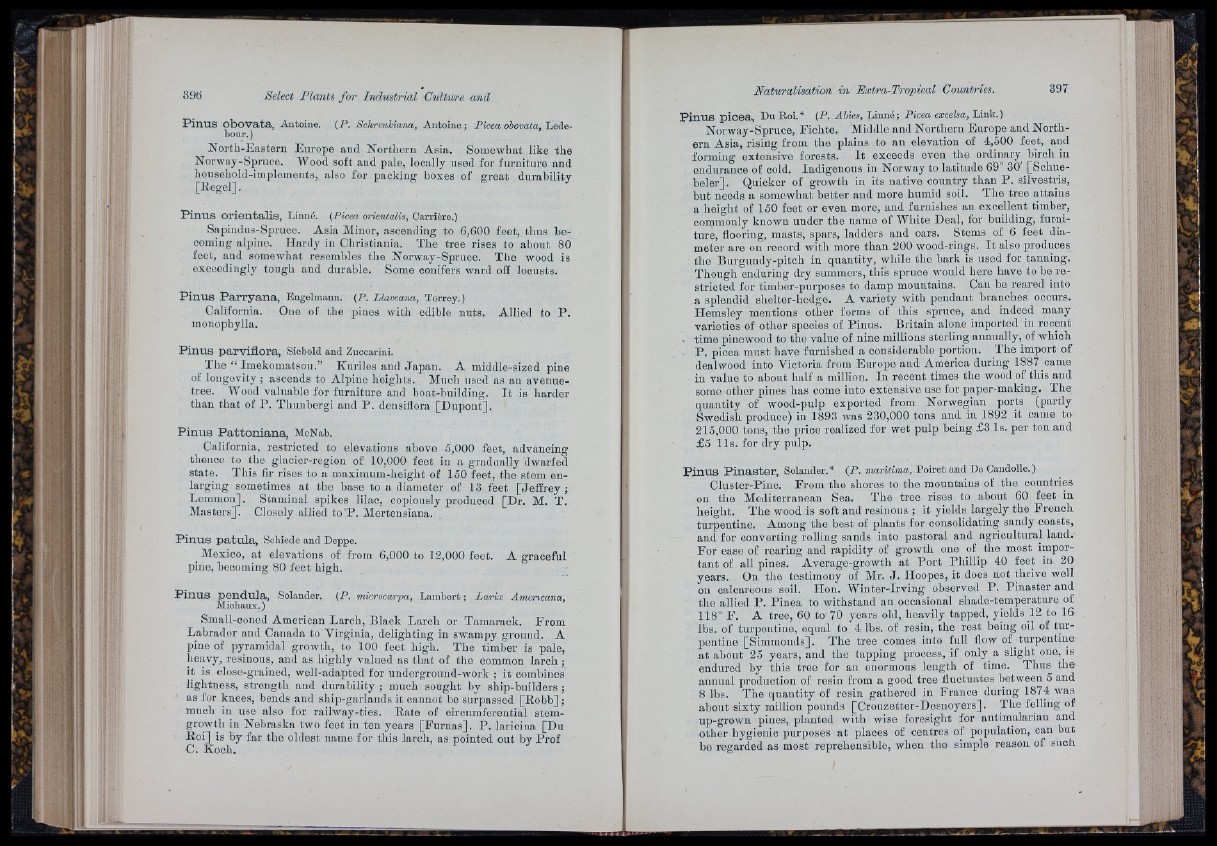
Pinus obovata, Antoine,
bour. )
{P. Schrenkiana, Antoine ; Picea obovata, Lede-
North-Eastern Europe and Northern Asia. Somewhat like the
Norway-Spruce. Wood soft and pale, locally used for furniture and
household-implements, also for packing boxes of great durability
[Rogel].
Pinus orientalis, Linné. [Picca orientalis, Carrière.)
Sapiudns-Spruce. Asia Minor, ascending to 6,600 feet, thus becoming
alpine. Hardy in Christiania. The tree rises to about 80
feet, and somewhat resembles the Norway-Spruce. Tlie wood is
exceedingly tough and durable. Some conifers ward off locusts.
Pinus Parryana, Engelmann. (P. Llaveana, Torrey.)
California. One of the pines with edible nuts. Allied to P .
monophylla.
Pinus parviflora, Siebold and Zuccarini.
The “ Imekomatsou.” Knriles and Japan. A middle-sized pine
of longovity ; ascends to Alpine heights. Much used as an avenue-
tree. Wood valuable for furniture and boat-building. I t is harder
than th a t of P . Thunbergi and P . densiflora [Dupont].
Pinus Pattoniana, MeNab.
California, restricted to elevations above 5,000 feet, advancing
tlience to the glacier-region of 10,000 feet in a gradaally dwarfed
state. This fir rises to a, maximum-height of 150 feet, the stem enlarging
sometimes a t the base to a diameter of 13 feet [Jeffrey ;
Lemmon]. Stamiual spikes lilac, copiously produced [Dr. M. T.
Masters]. Closely allied to 'P . Mertensiana.
Pinus patula, Schiede and Deppe.
Mexico, at elevations of from 6,000 to 12,000 feet,
pine, becoming 80 feet high.
A graceful
Pinus pendula, Solander. (P. microcarpa, Lambert; Larix Americana,
Michaux.)
Small-coned American Larch, Black Lai'oh or Tamarack. From
Labrador and Canada to Virginia, delighting in swampy gToimd. A
pine of pyramidal growth, to 100 feet high. The timber is pale,
heavy, resinous, and as liighly valued as th a t of the common larch ;
it is close-grained, well-adapted for undergronud-work ; it combines
iiglitness, strength and durability ; much sought by ship-builders ;
as for knees, bends and sliip-garlands it cannot he surpassed [Robb] ;
much in use also for railway-ties. Rate of circumferential stem-
growth in Nebraska two feet in ten years [Fnrnas]. P . laricina [Du
Roi] is by far the oldest name for tliis larch, as pointed out by Prof
C. Koch.
P i n p s p ic e a , Du Roi. * [P. Abies, Linné ; Picea excelsa, Link. )
Norway-Spruce, Fichte. Middle and N orthern Europe and Northern
Asia, rising from the plains to an elevation of 4,500 feet, and
forming extensive forests. I t exceeds even the ordinary birch in
endurance of cold. Indigenous in Norway to latitude 69° 30' [Sclmebeler].
Quicker of growth in its native country than P . silvestris,
hut needs a somewhat bettor and more humid soil. The tree attains
a height of 150 feet or even more, and furnishes an excellent timber,
commonly known under the name of White Deal, for building, furniture,
flooring, masts, spars, ladders and oars. Stems of 6 feet diameter
are on record with more than 200 wood-rings. I t also produces
the Burgnndy-pitch in quantity, while the bark is used for tanning.
Though enduring dry summers, this spruce would here have to be re stricted
for timber-purposes to damp mountains. Can be reared into
a splendid slielter-liedgo. A variety with pendant branches occurs.
Hemsley mentions other forms of this spruce, and indeed many
varieties of other species of Pinus. Britain alone imported in recent
. time pinewood to the value of nine millions sterling an n u a lly o f which
P . picea must have furnished a considerable portion. The import of
dealwood into Victoria from Europe aud America during 1887 came
iu value to about half a million. In recent times the wood of this and
some other pines has come into extensive use for paper-making. The
quantity of wood-pulp exported from Norwegian ports (partly
Swedish produce) in 1893 was 230,000 tons aud in 1892 it came to
215,000 tons, the price realized for wet pulp being £3 Is. per ton aud
£5 11s. for dry pulp.
P i n u s P i n a s t e r , Solander.* {P. maritima, Poiret and De Candolle.)
Cluster-Pine. From the shores to the mountains of the countries
on the Mediterranean Sea. The tree rises to about 60 feet in
height. The wood is soft and resinous ; it yields largely the Frencli
turpentine. Among the best of plants for consolidating sandy coasts,
and for converting rolling sands into pastoral and agricultural land.'
For ease of rearing aud rapidity of growth one of the most important
of all pines. Average-growth a t P o rt Phillip 40 feet in 20
years. Ou the testimony of Mr. J . Hoopes, it does not thrive well
on calcareous soil. lio n . Winter-Irving observed P. Pinaster and
the allied P . Piuea to withstand an occasional shade-temperature of
118° F. A treo, 60 to 70 years old, heavily tapped, yields 12 to 16
lbs. of turpentine, equal to 4 lbs. of resin, the rest being oil of tu rpentine
[Simmonds]. The tree comes into full flow of turpentine
a t about 25 years, and tho tapping process, if only a slight one, is
endured by this tree for an enormous length of time. Thus the
annnal production of resin from a good tree fluctuates between 5 and
8 lbs. The quantity of resin gathered in France during 1874 was
abont sixty million pounds [Crouzetter-Desuoyers]. The felling of
up-grown pines, planted with wise foresiglit for antimalarian and
other hygienic purposes a t places of centres of population, can but
be regarded as most reprehensible, when the simple reason of such